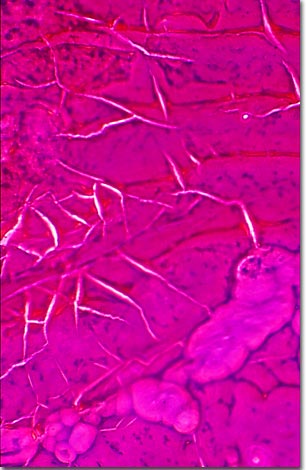Phase Contrast Image Gallery
Fish Cycloid Scale
A stained thin section of fish cycloid scale, illustrated below, was photographed using phase contrast optics. The image was captured using an Olympus IX-70 inverted microscope equipped with a DP-10 digital camera.

Cycloid scales are smooth, flat, and round with concentric lines called circuli. This type of overlapping scale demonstrates added flexibility and grows larger as the fish grows. In some species, cycloid scales possess annual growth rings. Scales, divided into several categories on the basis of composition and structure, provide protection from the environment and predators and are found on almost all fish. Fish scales are formed from skeletal elements (bone) that emerge from the dermal layer of skin. Other types of scales include bony, spiny projections with an enamel-like covering termed placoid scales. Another group of scales is similar to placoid scales, but are covered with an enamel-like substance called ganolin. Many scientists believe that teeth evolved from placoid scales. Cycloid scales are found on advanced fish species such as trout, herring, and carp.
BACK TO THE PHASE CONTRAST GALLERY
